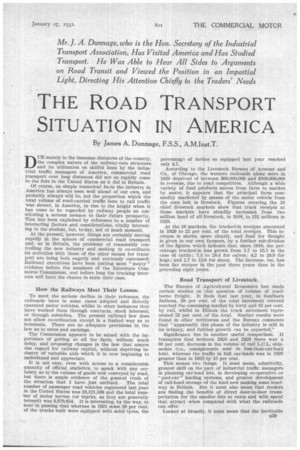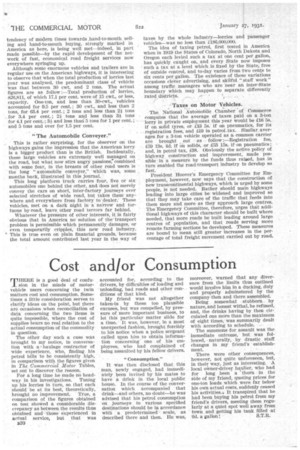THE ROAD TRANSPORT SITUATION IN AMERICA
Page 47

Page 48

If you've noticed an error in this article please click here to report it so we can fix it.
By James A. Dunnage, F.S.S., A.M.Inst.T.
Mr. J. A. Dunnage, who is the Hon. Secretary of the Industrial Transport Association, Has Visited America and Has Studied Transport. He Was Able to Hear All Sides to Arguments on Road Transit and Viewed the Position in an Impartial Light, Directing His Attention Chiefly to the Traders' Needs
DUE mainly to the immense distances of the country, the complex nature of the railway-rate structure and its utilization on skilful lines by the industrial traffic managers of America, commercial road transport over long distances did not so rapidly come to the fore in the United States as it did in Britain.
Of course, on simple numerical facts the industry in America has always been well ahead of our own, and probably always will be, but the proportion which the total volume of road-carried traffic bore to rail traffic was slower, in America, to rise to the height when it has come to be regarded by railway people as constituting a serious menace to their future prosperity. This has been explained by reference to a number of interacting factors and considerations, vitally interesting to the student, but, to-day, not of much moment.
At the present, however, things are certainly moving rapidly in the sphere of commercial road transport and, as in Britain, the problems of reasonably controlling the new industry and seeking to co-ordinate its activities with those of the other means for transport are being both eagerly and anxiously canvassed. Railroad executives have been putting most " meaty " evidence before the members of the Interstate Commerce Commission, and before long the trucking interests will have the chance to state their case.
How the Railways Meet Their Losses.
To meet the serious decline in their retenues, the railroads have in some cases adopted and directly operated motor vehicles, whilst in other instances they have worked them through contracts, stock interests, or through subsidies. The present railroad law does not allow co-ordination except in a limited way as to terminals. There are no adequate provisions in the law as to rates and earnings.
The Commission appears to be seized with the importance of getting at all the facts, without much delay, and proposing changes in the law that assure due regard for railway capital, without depriving industry of valuable aids which it is now beginning to understand and appreciate.
It is not easy, even with access to a considerable quantity of official statistics, to speak with any certainty as to the volume of goods now conveyed by road, but there is ample evidence of the general truth of the situation that I have just outlined. The total number of passenger road vehicles registered last year in the United States was 23,121,589 and the total number of motor lorries (or trucks, as they are generally termed) was 3,379,854. It is interesting, by the way, to note in passing that whereas in 1921 some 29 per cent. of the trucks built were equipped with solid tyres, the
percentage of lorries "so equipped last year reached only 4.7.
According to the Livestock Bureau of Armour and Co., of Chicago, the western railroads alone were in 1929 deprived of between $90,000,000 and $100,000,000 in revenue, due to road competition. Although a wide variety of food products moves from farm to market by motor, it appears that the principal farm commodity marketed by means of the motor vehicle from the corn belt is livestock. Figures covering the 16 chief livestock markets show that truck receipts at those markets have steadily increased from two million head of all livestock, in 1918, to 13i millions in 1929.
At the 16 markets, the trucked-in receipts amounted in 1929 to 22 per cent, of the total receipts. This increase is shown more clearly, and food for thought is given to our own farmers, by a further sub-division of the figures which indicate that, since 1918, the percentage trucked-in has grown from 1.7 to 13.5 in the case of cattle; 7.3 to 28.6 for calves ; 4.2 to 28.9 for hogs ; and 1.7 to 12.8 for sheep. The increase, too, has been far steeper in the past three years than in the preceding eight years.
Road Transport of Livestock.
The Bureau of Agricultural Economics has made certain studies on this question of volume of roadborne freight. It finds that last year, in Southern Indiana, 38 per cent. of the total movement covered reached the consuming market by lorry and 62 per cent. by rail, whilst in Illinois the truck movement represented 23 per rent. of the total. Similar results were found in other territories and the Bureau comments that "apparently this phase of the industry is still in its infancy, and further growth can be expected."
Significance lies in another useful comparison. It transpires that between 1920 and 1928 there was a 30 per cent, decrease in the volume of rail L.C.L. shipments (i.e., consignments sent in less-than-car-load lots), whereas the traffic in full car-loads was in 1928 greater than in 1920 by 15 per cent.
This means two things. It must mean, admittedly, greater skill on the part of industrial traffic managers in planning ear-load lots, in developing co-operative or "pool-ear" loading systems, and greater development of rail-head storage of the kind now making some headway in Britain. But it must also mean that traders are finding the benefits of direct door-to-door transportation for the smaller lots at rates and with speed that attract when compared with what the railroads can offer.
Looked at broadly, it must mean that the inevitable 1329 tendency of modern times towards _hand-to-mouth selling and hand-to-mouth buying, strongly marked in America as here, is being well met—indeed, in part made possible—by the rapid development of the network of fast, economical road freight services now everywhere springing up.
Although some enormous vehicles and trailers are in regular use on the American highways, it is interesting to observe that when the total production of lorries last year was analysed, the predominant class of vehicle was that between 30 cwt. and 2 tons. The actual figures are as follow :—Total production of• lorries, 826,811, of which 17.1 per cent, were of 15 cwt., or less, capacity. One-ton, and less than 30-cwt., vehicles accounted for 9.5 per cent.; 30 cwt., and less than 2 tons, for 63.4 per cent.; 2 tons and less than 2i tons for 3.4 per cent.; 2i tons and less than 31= tons for 4.1 per cent.; 3i and less than tons for 1 per cent.; and 5 tons and over for 1.5 per cent.
"The Automobile Conveyer."
_ This is rather surprising, for the observer on the highways gains the impression that the American lorry is a bigger product than is the British. Incidentally, these large vehicles are extremely well managed on the road, but what now stirs angry passions7 combined with some fear, in the breasts of other road users is the long "automobile conveyer,". Which was, some months back, illustrated in this journal.
This long platform truck carries four, five or six automobiles one behind the other, and does not merely convey the cars on short, inter-factory journeys over selected stretches of wide road, but takes them anywhere and everywhere from factory to dealer. These vehicles, met on a dark night in a' narrow and tortuous by-road, leave other road terrors far behind.
Whatever the pressure of other interests, it is fairly obvious that in America no solution of thetranSport • problem is permissible which permanently damages, or even temporarily cripples, this new road industry. ' This is true even on plain financial grounds, -because the total amount contributed last year in the way of
taxes by the whole industry—lorries and passenger vehicles—was no less than £186,000,000.
The idea of taxing petrol, first tested in America when in 1919 the States of Colorado, North Dakota and Oregon each levied such a tax at one cent per gallon, has quickly caught on, and every State now imposes such a tax at a level which is fixed by the State, free of outside control, and to-day varies from two cents to six cents per gallon. The existence of these variations occasions clever advertising, and skilful "staff work" among traffic managers who are near an inter-State boundary which may happen to separate differently rated districts. „ • '
Taxes On Motor yehicles.
The National Automobile Chamber of Commerce computes that the average of taxes paid on a 3-ton 'lorry in private employment this year would be £16 5s. if on solid tyres, or £13 5s. if on pneumatics, for its .registration fees, and La in petrol ,tax. Similar_ averages for a 3-ton vehicle operated as 11) common carrier are brought out as follow :—Registration fee, £59 13s. 4d. if On solids, or £53 15s. ifon pneumatics; and, in petrol tax, £38. Obviously the active policy of highway construction and improvement, made possible in a measure by the funds thus raised, has in turn enabled the road-transport industry to develop so fast.
['resident Hoover's Emergency Committee for Employment, however, now says that the construction of new transcontinental highways, which is urged by some people, is not needed. Rather should main highways leading into large cities be widened and improved so that they may take care of the traffic that feeds into them more and more as they approach large centres. The Emergency Committee, therefore, urges that additional highways of this character should be built where needed, that more roads be built leading around large centres of population, and that roads serving more remote farming sections be developed. These measures are bound to mean still greater increases in the percentage of total freight movement carried out by road.




































































































